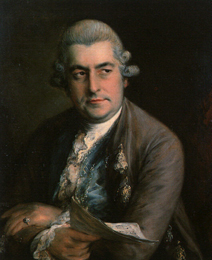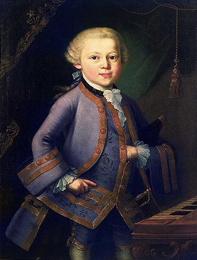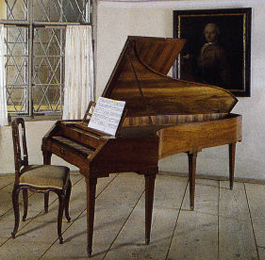
Mozart and the Piano Concerto
Wolfgang Mozart wrote comfortably in all genres, but two in particular inspired him to some of his greatest achievements: the opera, and the piano concerto. Mozart's piano concertos contain some of his most intensely personal and dramatic music, and as such have been the subject of fascination for centuries.
The story of the Mozart concertos features an unsung hero -- Johann Christian Bach, youngest son of the titanic Sebastian. Christian was originally trained in music by his father; upon Sebastian's death in 1750 the fifteen-year-old boy went to live with his half-brother, Carl Phillip Emmanuel Bach, who continued the boy's education in the family business, just as he himself had been taught by their mutual father. At the age of 20 Christian then moved on to Italy (not entirely with the family's blessing) and received finishing work from the master pedagogue Padre Martini, all the while sharpening his craft in the hurly-burly of Italian opera seria.
The 27-year-old musician, beneficiary of one of the finest musical educations imaginable, arrived in England in 1762 and lost no time establishing himself as the hottest opera composer in town. By 1764 he had teamed up with gambist-composer Carl Friedrich Abel (himself a pupil of Sebastian Bach) for the so-called Bach-Abel concerts, a long-lasting series which stands as a significant landmark on the way to the modern concert world.

Gainsborough's portrait of Christian Bach
Leopold Mozart brought his children Wolfgang and Nannerl to London in 1764, part of the family's first European tour. Christian quickly took the eight-year-old Wolfgang under his wing and became the second great mentor in Mozart's life (the first being his own father.) Christian's influence on Mozart's development and style was profound and long-lasting. Wolfgang went so far as to set three of Christian's Opus 5 piano sonatas as piano concertos, and carried a manuscript copy of a Christian piano sonata back to Austria.

Mozart in childhood
Hearing a Christian Bach clavier concerto can be a bit disconcerting, especially if one is listening blind -- i.e., without knowing the composer beforehand. One might think that one is hearing a hitherto-unknown Mozart concerto, albeit not one of the late ones. Christian's overall style, his interleaving of the piano with the orchestra, is remarkably Mozartean -- that is, Mozart's concerto style is remarkably Christian Bachian. Even some of the details of Mozart's orchestral practices, such as his preference for widely-spaced wind sonorities, are also found in Christian Bach. (Whether or not that reflects Christian's direct influence cannot be determined with precision.)
Mozart was also familiar with some of Abel's symphonies -- one of which was, in fact, falsely attributed to Mozart for some time.
Christian Bach died in 1782, his reputation in decline. Happily, he and Mozart had met again in 1778 in Paris.
Mozart wrote piano concertos from 1767 onwards, but it is the works from his decade in Vienna (1781 - 1791) that truly transformed the genre. He wrote them for his "academies" -- the public subscription concerts that were his primary source of income.
The composition dates for the seventeen Vienna-period piano concertos can be consulted as a fairly reliable indicator of Mozart's current fortunes as a freelancing musician. From 1782 to 1786 he was clearly living high, basking in the heady rush of being Vienna's musical boy-toy du jour. This period may have peaked around 1784 when he wrote no fewer than six concertos, indicating that he was giving an unprecedented number of high-profile public performances. But by 1789 the bubble had burst and he could no longer attract enough interest to support the concerts; the fickle Viennese had apparently tired of their little plaything. As the end of Mozart's tragically short life approached, he completed only one last concerto, this time for solo clarinet -- surely one of most sublime creations in all music -- while his production of piano concertos diminished to a trickle, with K. 595 (possibly begun as early as 1788) marking the last of the series.

Mozart's fortepiano
The piano concertos run the full temperature range of Mozart's style -- dramatic, cheerful, depressed, insouciant, hard-edged, ingratiating, frothy, challenging. A stormy first movement, such as in the D Minor concerto, might be followed by a slow movement of such bewitching lyricism as to banish all thoughts of darkness or despair. Peppy variations movements stand shoulder-to-shoulder with expansive, almost wastefully lavish, first movements of unprecedented length and emotional scope. No two are alike and all merit any amount of time and attention.
It's worth remembering that Mozart not only performed the solo piano part, but that he actually played much of it from memory or by improvising, given that he wrote out only a sketch of his intentions for the piano, and nothing at all for the cadenzas, which were truly impromptu. He might notate the complete solo piano part at a later date -- if ever. Many of the later Mozart piano concertos do not feature fully-realized solo piano parts, although those he wrote for other performers (such as No. 17 in G Major, K. 453, for Barbara Ployer) are completely finished.
Public improvisation was as common in Mozart's day as it is uncommon in today's concert hall. (The jazz and pop worlds offer a different state of affairs.) Playing extempore is so atypical in the concert hall, in fact, that most pianists prefer to play pre-digested cadenzas for the Mozart concertos rather than cooking up their own, either on the spot or after a bit of planning beforehand. Improvisation has become largely a lost art amongst concert musicians, although with the increasing attention paid to historically-informed performance practice, true at-the-moment improvisation is creeping back into performances, albeit tentatively.
In the eighteenth century, composer-performers placed strong emphasis on the audience's immediate reaction, in a freely-expressive environment far removed from the museum culture of 'classical' music today. Consider Mozart's letter home about his "Paris" symphony, K. 297 in D Major:
Just in the middle of the first Allegro there was a passage I was sure would please. All the listeners went into raptures over it--applauded heartily...I introduced it once more towards the end--and it was applauded all over again.
Although modern practice discourages applause between movements, much less during the movement, spontaneous feedback was the norm in Mozart's day, just as it is today in a jazz club. You heard something you liked, you applauded. But times change, and attitudes change, not necessarily for the worse or better. They just change.
We have a Mozart piano concerto coming at the SF Symphony, as Piotr Anderszewski performs No. 24 in C Minor under the leadership of guest conductor Stéphane Denève. The concerts are as follows:
- Thursday, April 9 at the Flint Center in Cupertino, 8:00 PM
- Friday, April 10 at Davies Symphony Hall, 8:00 PM
- Saturday, April 11 at Davies Symphony Hall, 8:00 PM
Works by Fauré, Debussy, and Jennifer Higdon are also on the program. Here's the page for the appropriate information, including tickets.
If you'd like to read up a bit on Mozart and the piano concerto, I strongly recommend Richard Taruskin's Oxford History of Western Music, Volume 2, Chapter 30 "The Composer's Voice", pages 589 through 639 in the hardcover edition. This magisterial overview of Western music, the product of a single author free of the usual restraints imposed by school boards, textbook committees, or demands for political correctness, is an absolute must: entertaining, informative, juicy, passionate, opinionated, persuasive, and endlessly fascinating. Fortunately it's coming out gradually in less-expensive paperback volumes, although Volume 2 isn't available yet. For now you can access Volume 2 at your local public library, or by coughing up $494.70 to Amazon for the entire six-volume set -- a nice discount from the jaw-dropping full retail of $750.00. (Amazon also links to some slightly cheaper used copies.)
Choices abound for listening; I count 117 CDs available from ArkivMusic. Piotr Anderszewski can be heard with the Sinfonia Varsovia, on Virgin Classics. An inexpensive 2-CD compilation features Alfred Brendel and Sir Neville Marriner conducting the Academy of St. Martin in the Fields, on Philips. The same label is your source for the complete Mozart concertos from Mitsuko Uchida with Jeffrey Tate and the English Chamber Orchestra.
